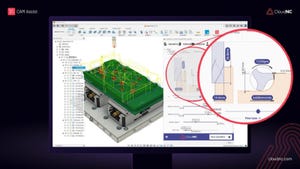Vaupell Develops CFRP Aircraft Parts
June 3, 2010

Carbon-fiber reinforced Ultem polyetherimide plastic isnow being validated for use in aircraft interiors, replacing aluminum.
Vaupell, aglobal contract manufacturer of custom injection-molded components and assemblies,is working with Sabic Innovative Plastics to validate CFRP Ultempolyetherimide in aircraft tray table arm components.
Concept parts reveal a 50 percent weight savings and upto 40 percent improved strength of carbon-fiber-filled Ultem resin versus diecast aluminum.
"Working closely with Sabic Innovative Plastics, weimmediately saw the potential of carbon-fiber-filled Ultem resin to replacealuminum in interior aircraft applications," says Mike Hamm, vice president,Sales, Vaupell. "Carbon-fiber-filledUltem resin is a true industry game changing material that not only slashespart weight for greater fuel savings, but also offers a balance of otherhigh-performance properties to meet aircraft industry demand."
Carbon fiber-filled Ultem resin complies with FAAflammability FAR 25.853, smoke density and heat release requirements for OSU65/65. In addition to tray table arms, potential applications for the newcarbon-fiber-filled Ultem grades include armrests, footrests and galley itemssuch as coffee maker chassis. Vaupell will conduct further load capabilitytesting and fatigue testing later this year.
Gradeslate
Sabic Innovative Plastics has developed a family of carbon-fiber-filledUltem resin technologies with varying fiber content to address specific demandsfor top-end performance properties.
Aerospace-grade carbon fibers provide tensile strength of38.3 PSI versus die cast aluminum grade 2024-0 (27 PSI) and machined (tempered)aluminum grade 7075-0 (33.1 PSI). Continuous long fibers provide exceptionalstiffness and impact resistance.
The Ultem resin materials also have approximately 50percent lower specific gravity (SG) than aircraft-grade aluminum (2024-0: 2.78 SG; 7075-0: 2.81 SG; carbon-fiber-filled Ultem resin:1.44 SG).
In addition to reducing the weight of aluminum, injectionmolded carbon-fiber-filled resin components don't require machining and othersecondary processes, streamlining production and driving down total systemcosts. They also enable part consolidation to reduce points of failure andexpand design freedom as compared to metal.
The new resin grades can also be extruded into panels forgalley storage and similar applications. Components can be powder coated,painted or plated.
Vaupell was founded by Leonard Vaupell in Seattle, WA in1947 and supplied the first plastic parts to Boeing. In 1998, Vaupell became part of HIG Capital, a private equity companyheadquartered in Miami, FL. The company operates more than 110 injectionmolding presses that range in size from 17 tons to 1000 tons of clampingpressure.
It was not known if the new Ultem components will be usedon the Dreamliner.The CFRP parts used in the fuselage of the Dreamliner are made with athermosetting plastic resin that cannot be injection molded.
Polyetherimide (PEI) is an amorphous,amber-to-transparent thermoplastic with high heat resistance and strength. 
Vaupell Develops CFRP Aircraft Parts A
About the Author(s)
You May Also Like



.jpg?width=300&auto=webp&quality=80&disable=upscale)

